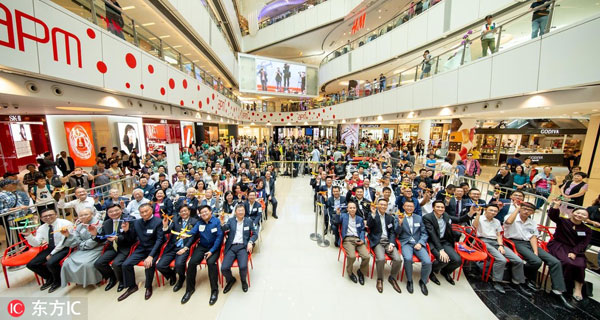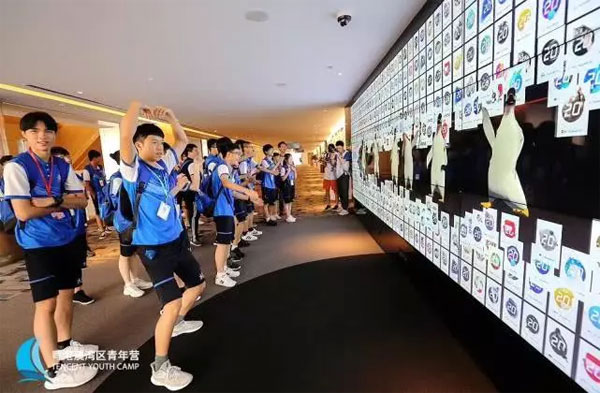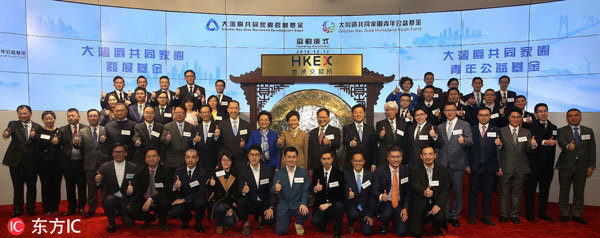Greater Bay Area's current, future co-op in talents

The outline development plan for the Guangdong-Hong Kong-Macao Greater Bay Area, which was unveiled by Chinese authorities on Feb 18, aims to develop the region into an international first-class bay area and a world-class city cluster, especially as an international innovation and technology hub.
The Greater Bay Area is composed of nine cities in the Pearl River Delta region – Guangzhou, Shenzhen, Dongguan, Foshan, Zhuhai, Zhaoqing, Zhongshan, Jiangmen and Huizhou in Guangdong province – as well as Hong Kong Special Administrative Region and Macao Special Administrative Region.

The opening ceremony of the Greater Bay Area Youth UAV Contest is held Oct 13, 2018, in Hong Kong to strengthen youth’s understanding of the Greater Bay Area and jointly cultivate more scientific talents. [Photo/IC]
Talents play a vital part in achieving the above goals, which provide safeguards for the high-quality, sustainable and innovative development of the region, said Zhang Xichun, secretary of the Party Committee of South China University of Technology.
Cities in the Greater Bay Area have long been cooperating with each other to cultivate talents, as well as attract and retain ones from outside the area.
In November 2016, 26 universities in the region, including nine from Hong Kong and seven from Macao, founded a university alliance to seek breakthroughs in cooperation in teaching and scientific research, and to realize resource sharing.
Besides, colleges and universities in the Greater Bay Area jointly established laboratories and talents exchange programs through various enterprises, including China's internet giant Tencent's program, Tencent Youth Camp, to promote the cultivation of talents. About 190 undergraduate programs, 78 platforms and five joint laboratories have been set up in the Greater Bay Area.

Teenagers from the Greater Bay Area visit the global headquarters of China's internet giant Tencent in Nanshan district, Shenzhen, in South China's Guangdong province. The company launched its new youth exchange program Feb 25, based on its former Tencent Youth Camp as a response to the development plan for the Greater Bay Area. [Photo/tech.qq.com]
Zhang noted that the Greater Bay Area has a good foundation for talent cultivation, and for the development of the region into a global highland for innovative talents.
There are a total of about 150 universities and colleges in the region, of which five have been included in the global top 100 in the 15th edition of the QS World University Rankings, which was released in June 2018 by QS Quacquarelli Symonds, a higher education analyst firm.
As well, the region has an advantage over the Beijing-Tianjin-Hebei region and the Yangtze River Delta region in openness, internationalization, economic development levels and innovation.
Therefore, institutional innovation and reform must be sped up to build a convenient environment in the Greater Bay Area for the cultivation, attraction and retention of talents, Zhang said.
A new type of higher education system should be formed in the Greater Bay Area. Zhang supports the development of a first-class university cluster in the region and a feasibility study into establishing a new mechanism for universities, enterprises and society to jointly cultivate high-end talents.
He also encourages major cities in the Greater Bay Area to foster high-level talents across borders and in schools, as well as youths in the region to cooperate in starting businesses. Great importance must be attached to cooperation among all these institutions in Guangdong province, Hong Kong and Macao in scientific and technological innovation, and joint cultivation of innovative and career-creating talents.

The Greater Bay Area Homeland Youth Fund, which was launched in December 2018, is aimed at helping youths to take up an occupation or start a business in the region. [Photo/IC]
A talent attraction mechanism aimed at outstanding overseas youths should be set up and improved. Zhang noted that the existing talent management systems in the Greater Bay Area have differences in treatment of talents. It is necessary to form a unified talent market in the region, he said.
Further exploration into relaxing the restrictions on project applications and setting up special funds should be stepped up in the region to attract more talents from outside the area. A fair and competitive environment will be also created to boost the development of innovative talents.
A scientific talent retention system should be established in the Greater Bay Area. According to Zhang, Guangdong, Hong Kong and Macao should co-establish and share with each other talent incentive and competition mechanisms.
The current systems for the application of scientific and technological projects, and the management of scientific research funds should be improved; the distribution mechanisms for the transformation of scientific and technological achievements and their incomes need to be updated; supporting and incentive mechanisms for technological innovation and entrepreneurship in the Greater Bay Area ought to be improved to build the region into an attractive place for talents.







